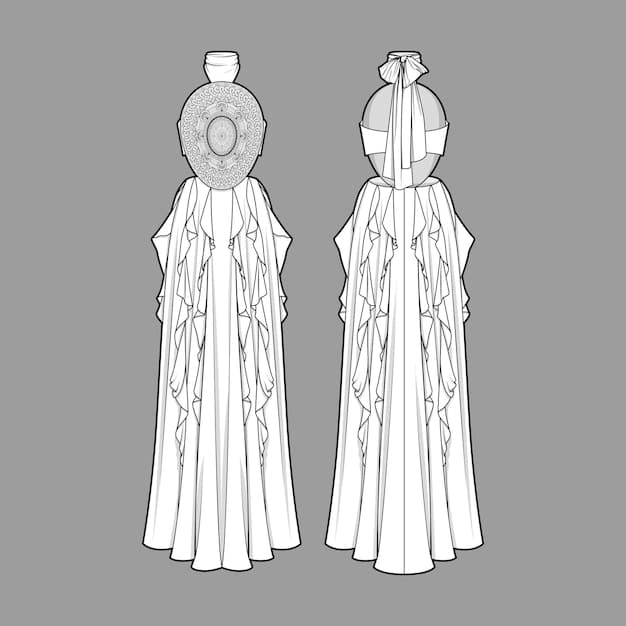Unveiling Limited Series Budgets: Production Costs & Storytelling Impact

Limited series budgets significantly influence storytelling and visual effects, dictating the scope and ambition of a production, from securing top talent to crafting intricate narratives.
The allure of a limited series often lies in its concentrated narrative and high production values. However, the financial realities behind these projects, specifically limited series budgets, profoundly shape the creative choices and visual spectacle that audiences experience. Understanding how production costs influence storytelling and visual effects is key to appreciating the art and business of television.
Understanding the Landscape of Limited Series Budgets
Limited series have become a dominant force in television, offering compelling narratives in a concise format. But what exactly goes into crafting the budgets that bring these stories to life? Let’s delve into the key factors that influence the financial planning of a limited series.
Key Factors Influencing Budget Size
Several elements contribute to the ultimate budget allocation of a limited series. These factors can range from above-the-line talent to below-the-line expenses, all playing critical roles in the overall cost.
- Star Power: Securing A-list actors and directors can significantly inflate a budget. Their salaries often represent a substantial portion of the total funds.
- Production Location: Filming in major cities or exotic locales tends to be more expensive than shooting in smaller towns or studio lots.
- Period Pieces: Historical dramas require meticulous attention to detail in costumes, sets, and props, increasing the cost of production design.
- Visual Effects: Series that heavily rely on CGI and visual enhancements demand significant investment to achieve a polished and believable look.
Ultimately, the interplay of these elements determines the budget range, influencing the storytelling scope and visual grandeur that can be achieved.
In conclusion, grasping the diverse elements that define limited series budgets forms the bedrock for comprehending production choices. It influences everything, from the narrative depth to how captivating the visuals are.

The Direct Impact of Budget on Storytelling
The available budget has a profound impact on the narrative possibilities within a limited series. How resources are allocated can either amplify or restrict the depth and complexity of the storyline.
Narrative Scope and Character Development
Adequate funding allows writers to explore intricate plotlines and fully develop characters. A larger budget makes it easier to afford more filming time, enabling detailed character arcs and complex relationships.
Conversely, budget constraints may force writers to streamline the story, cutting subplots or reducing the number of characters. This constriction can lead to a less immersive and satisfying narrative experience.
The Role of Writing and Script Development
A well-funded production can invest more in the writing process, allowing for multiple drafts and thorough script revisions. This investment leads to a more polished and nuanced script.
- Extended Writing Time: More time allows writers to refine the plot and dialogue.
- Research Investment: Proper funding enables thorough research for accuracy and depth.
- Expert Consultants: Hiring consultants ensures credibility and authenticity in the narrative.
Poorly funded productions often rush through the writing phase, resulting in weaker scripts and less compelling storytelling.
To summarize, the financial backing significantly dictates a story’s possible depth, character development, and overall effectiveness. By investing wisely in development, production teams can ensure the quality of the story being told.
Visual Effects and Spectacle: A Budget’s Best Friend (or Worst Enemy)
Visual effects (VFX) and large-scale action sequences are frequently integral components of limited series, adding significantly to their visual attractiveness. However, the quality and extent of these elements are predominantly dictated by the budget available.
Achieving High-Quality Visuals on a Limited Budget
Even with a modest budget, it’s possible to achieve compelling visuals through creative problem-solving and resourcefulness.
Techniques such as:
- Strategic shot composition
- Clever use of practical effects
- Minimizing VFX shots
These can help to enhance the visual narrative without bankrupting the production.
The Pitfalls of Underfunded VFX
Insufficient funding for VFX often leads to compromised visuals that can detract from the overall viewing experience. Rushed timelines and inadequate resources can result in unrealistic effects and unconvincing CGI.
The difference between high-quality and underfunded VFX is often obvious, potentially ruining the immersive experience for viewers.

In conclusion, visual effects often make the story more impactful but must be funded adequately so as not to detract from the experience. Creative resource management can sometimes help, but compromise is almost always required when funding is too low.
Case Studies: Budget Strategies in Popular Limited Series
Examining successful limited series can provide valuable insights into how budget strategies influenced their quality and reception. Analyzing different approaches highlights the delicate balance between financial limitations and creative ambitions.
“The Queen’s Gambit”: A Focus on Story and Performance
“The Queen’s Gambit” achieved critical acclaim with a relatively modest budget by focusing on character-driven storytelling and strong performances rather than extravagant visual effects.
The production team prioritized:
- Authentic sets and costumes
- Detailed character development
- Compelling performances
These elements elevated the series despite its budget limitations.
“Chernobyl”: Investing in Authenticity and Realism
“Chernobyl” invested heavily in meticulous research and practical effects to authentically recreate the disaster. This dedication to detail contributed to the series’ powerful and unsettling realism.
The production team prioritized:
- Extensive research
- On-location shooting
- Authentic props and costumes
All of which made the series a resounding success.
In summary, the strategic allocation of resources is key to the success of any limited series, as highlighted in these contrasting examples. Every series must prioritize what it wants to excel at and adequately fund those key aspects.
Strategies for Managing Production Costs Effectively
Effective budget management is critical for any limited series. Implementing strategic approaches can help maximize resources, ensuring the final product meets creative expectations without exceeding financial constraints.
Pre-Production Planning and Script Refinement
Thorough pre-production planning lays the groundwork for cost efficiency by identifying potential challenges and optimizing the workflow.
- Detailed budgeting
- Realistic scheduling
- Comprehensive location scouting
These actions can preempt many issues during principal photography. Refining the script early on reduces the need for costly reshoots and revisions.
Utilizing Tax Incentives and Government Subsidies
Many regions offer tax incentives and subsidies to attract film and television productions. Taking advantage of these programs can significantly reduce overall costs.
Exploring incentives offered by:
- State and local governments
- International film commissions
Can provide substantial financial relief. Understanding how to navigate these programs is crucial for budget optimization.
Overall, proactively planning every aspect of production helps productions stay on target with the budget and avoid expensive unplanned scenarios.
The Future of Limited Series Budgets: Trends and Predictions
Looking ahead, several trends could impact limited series budgets. Understanding these shifts is vital for navigating the changing landscape of television production.
The Rise of Streaming Services and Increased Investment
The proliferation of streaming services has fueled increased investment in original content, including limited series. This competition for viewers is driving up budgets as streaming platforms seek to produce high-quality, visually stunning shows to attract subscribers.
Technological Advances and Cost-Saving Innovations
Technological advancements, such as virtual production and AI-assisted visual effects, offer potential cost-saving opportunities. These innovations can streamline the production process and reduce the need for expensive on-location shoots and extensive post-production work.
In conclusion, the investment in limited series is constantly growing due to competition between streaming services and technology is streamlining production in order to keep productions on budget.
| Key Point | Brief Description |
|---|---|
| 💰 Budget Factors | Talent, location, and visual effects drive budget size. |
| ✍️ Story Impact | Budget affects narrative scope, character depth, and script quality. |
| 🎬 Cases | Strategic budgeting led to success for “Queen’s Gambit” and “Chernobyl.” |
| 🚀 Future Trends | Streaming wars and tech innovations are shaping budgets. |
FAQ
▼
The main drivers include above-the-line costs such as actors’ salaries, directors’ fees, and writers’ compensation, as well as below-the-line costs like production design, visual effects, location fees, and crew wages.
▼
A tight budget can limit the narrative scope, reduce the number of characters, and force writers to simplify the plot, potentially resulting in a less immersive and less fulfilling storyline for the audience.
▼
Yes, creative solutions like strategic shot composition, clever use of practical effects, and minimizing VFX shots can help enhance visual appeal even with a modest budget. Careful planning is essential.
▼
Tax incentives and government subsidies can substantially lower overall production costs. Taking advantage of these financial programs is a key strategy for optimizing the budget and increasing production value.
▼
Advances like virtual production and AI-assisted visual effects provide potential cost-saving avenues bystreamlining processes, reducing reliance on expensive locations, and diminishing the need for intensive post-production efforts.
Conclusion
Ultimately, limited series budgets are a critical factor in determining the creative potential and visual quality that productions can achieve. By understanding the intricacies of these budgets and employing effective management strategies, filmmakers can navigate financial constraints while delivering compelling and visually striking narratives.





